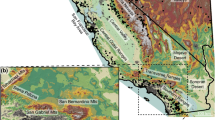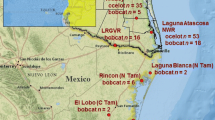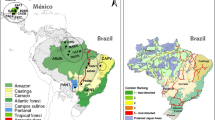Abstract
Natural resource extraction can represent a major human modification to the landscape. Habitat reclamation is becoming an increasingly important strategy for abating the loss of biodiversity associated with these developments; however, the demographic and genetic consequences of colonizing artificial habitat remain unknown in many species. Here, we investigated the genetic consequences of landscape modifications for the American pika (Ochotona princeps) relative to two major developments in British Columbia, Canada: a large open-pit copper mine (Highland Valley Copper) under partial reclamation and a bisecting major highway (97C). We assessed microsatellite genotypic data for 109 individuals across 15 sites located either within the mine on artificial habitat or on adjacent natural habitat both north and south of the highway. There were no significant differences in levels of heterozygosity, allelic richness or inbreeding between natural (n = 7) and artificial sites (n = 8). However, pikas residing on artificial habitat exhibited significantly higher relatedness estimates. Bayesian clustering analyses revealed two distinct genetic units corresponding to north and south of the highway, with further substructure detected in the south. Likewise, high genetic friction was detected in the central region of the area, largely corresponding to the highway and modified landscape associated with the mine. At a finer scale, pairwise estimates of differentiation and migration rates suggest little gene flow may be occurring among sites across the sampling area, with some evidence for directional migration from artificial to natural sites. Overall, artificial habitat has been successful in promoting occupancy for American pikas, however, barriers to gene flow likely associated with resource extraction and road construction limit connectivity across the landscape.



Similar content being viewed by others
References
Baguette M, Mennechez G, Petit S, Schtickzelle N (2003) Effect of habitat fragmentation on dispersal in the butterfly Proclossiana eunomia. C R Biol 326:200–209. doi:10.1016/S1631-0691(03)00058-1
Balkenhol N, Waits LP (2009) Molecular road ecology: exploring the potential of genetics for investigating transportation impacts on wildlife. Mol Ecol 18:4151–4164. doi:10.1111/j.1365-294X.2009.04322.x
Beever EA, Ray C, Mote PW, Wilkening JL (2010) Testing alternative models of climate-mediated extirpations. Ecol Appl 20:164–178. doi:10.1890/08-1011.1
Beever EA, Dobrowski SZ, Long J et al (2013) Understanding relationships among abundance, extirpation, and climate at ecoregional scales. Ecology 94:1563–1571. doi:10.1890/12-2174.1
Belkhir K, Borsa P, Chikhi L et al (2004) Genetix 4.05, logiciel sous Windows TM pour la génétique des populations. Lab. génome Popul. Interact. CNRS Umr 5000. Univ. Montpellier II, Montpellier
Benjamini Y, Hochberg Y (1995) Controlling the false discovery rate: a practical and powerful approach to multiple testing. J R Stat Soc Serise B 57:289–300
Bloodgood MA, Gizikoff KG, Jones CE (1998) Biosolids amendment of waste rock and tailings as reclamation treatment at Highland Valley Copper. In: 22nd British Columbia Mine Reclamation Symposium. Penticton, BC, Canada, pp 15–25
British Columbia Ministry of Transportation and Highways (2009) British Columbia Traffic Data Program. In: Traffic data Logan lake–28-950NS-N. http://www.th.gov.bc.ca/trafficData/TRADAS/tradas.asp?loc=28-950NS
Buchmann CM, Schurr FM, Nathan R, Jeltsch F (2013) Habitat loss and fragmentation affecting mammal and bird communities: the role of interspecific competition and individual space use. Ecol Inform 14:90–98. doi:10.1016/j.ecoinf.2012.11.015
Castillo JA, Epps CW, Davis AR, Cushman SA (2014) Landscape effects on gene flow for a climate-sensitive montane species, the American pika. Mol Ecol 23:843–856. doi:10.1111/mec.12650
Duforet-Frebourg N, Blum MGB (2014) Nonstationary patterns of isolation-by-distance: inferring measures of local genetic differentiation with bayesian kriging. Evolution (NY) 68:1110–1123. doi:10.1111/evo.12342
Durka W (1999) Genetic diversity in peripheral and subcentral populations of Corrigiola litoralis L. (Illecebraceae). Heredity 83:476–484. doi:10.1038/sj.hdy.6886000
Earl DA, VonHoldt BM (2011) Structure Harvester: a website and program for visualizing Structure output and implementing the Evanno method. Conserv Genet Resour 4:359–361. doi:10.1007/s12686-011-9548-7
Eaton BR, Fisher JT, McKenna GT, Pollard J (2014) An ecological framework for wildlife habitat design for oil sands mine reclamation. Oil Sands Research and Information Network, University of Alberta, School of Energy and the Environment, Edmonton, Alberta. OSRIN Report No. TR-67. 83
Eckert CG, Samis KE, Lougheed SC (2008) Genetic variation across species’ geographical ranges: the central-marginal hypothesis and beyond. Mol Ecol 17:1170–1188. doi:10.1111/j.1365-294X.2007.03659.x
Estes-Zumpf WA, Rachlow JL, Waits LP, Warheit KI (2010) Dispersal, gene flow, and population genetic structure in the pygmy rabbit (Brachylagus idahoensis). J Mammal 91:208–219. doi:10.1644/09-MAMM-A-032R.1
Evanno G, Regnaut S, Goudet J (2005) Detecting the number of clusters of individuals using the software Structure: a simulation study. Mol Ecol 14:2611–2620. doi:10.1111/j.1365-294X.2005.02553.x
Excoffier L, Lischer HEL (2010) Arlequin suite ver 3.5: a new series of programs to perform population genetics analyses under Linux and Windows. Mol Ecol Resour 10:564–567. doi:10.1111/j.1755-0998.2010.02847.x
Fischer J, Lindenmayer DB (2007) Landscape modification and habitat fragmentation: a synthesis. Glob Ecol Biogeogr 16:265–280. doi:10.1111/j.1466-8238.2006.00287.x
Frankham R (1996) Relationship of genetic variation to population size in wildlife. Conserv Biol 10:1500–1508
Freberg MR, Gizikoff KG (1999) Development and utilization of an end land use plan for highland valley copper. In: Proceendings of the 23rd Annual British Columbia Mine Reclamation Symposium. Kamploops, BC, Canada, pp 46–56
Gaines MS, Diffendorfer JE, Tamarin RH, Whitttam TS (1997) The effects of habitat fragmentation on the genetic structure of small mammal populations. J Hered 88:294–304
Guo SW, Thompson EA (1992) Performing the exact test of Hardy-Weinberg proportion for multiple alleles. Biometrics 48:361–372
Hafner DJ, Sullivan RM (1995) Historical and ecological biogeography of neararctic pikas (Lagomorpha: Ochotonidae). J Mammal 76:302–321
Henry P, Sim Z, Russello MA (2012) Genetic evidence for restricted dispersal along continuous altitudinal gradients in a climate change-sensitive mammal: the American pika. PLoS One 7:e39077. doi:10.1371/journal.pone.0039077
Howie R (2007) Habitat locations for the American pika (Ochotona princeps) in the Highmont area. Aspen Park Consult Kamploops, BC, Canada 1–13
Jensen JL, Bohonak AJ, Kelley ST (2005) Isolation by distance, web service. BMC Genet 6:13. doi:10.1186/1471-2156-6-13
Kalinowski ST (2005) Hp-Rare 1.0: A computer program for performing rarefaction on measures of allelic richness. Mol Ecol Notes 5:187–189. doi:10.1111/j.1471-8286.2004.00845.x
Keyghobadi N (2007) The genetic implications of habitat fragmentation for animals. Can J Zool 85:1049–1064. doi:10.1139/Z07-095
Kreuzer MP, Huntly NJ (2003) Habitat-specific demography: evidence for source-sink population structure in a mammal, the pika. Oecologia 134:343–349. doi:10.1007/s00442-002-1145-8
Lamb CT, Robson KM, Russello MA (2013) Development and application of a molecular sexing protocol in the climate change-sensitive American pika. Conserv Genet Resour 6:17–19. doi:10.1007/s12686-013-0034-2
Leberg PL (2002) Estimating allelic richness: effects of sample size. Mol Ecol 11:2445–2449
Lesica P, Allendorf FW (1995) When are peripheral valuable populations for conservation? Conserv Biol 9:753–760
Martínez-Cruz B, Godoy JA, Negro JJ (2007) Population fragmentation leads to spatial and temporal genetic structure in the endangered Spanish imperial eagle. Mol Ecol 16:477–486. doi:10.1111/j.1365-294X.2007.03147.x
Mayr E (1963) Animal species and evolution. Harvard Univeristy Press, Cambridge, MA
Meredith SJ (2002) The impact of habitat spatial structure on pika (Ochotona princeps) dispersal dynamics. University of Nevada, Reno, NV
Moilanen A, Smith AT, Hanski I (1998) Long-term dynamics in a metapopulation of the American pika. Am Nat 152:530–542. doi:10.1086/286188
Nei M, Maruyama T, Chakraborty R (1975) The bottleneck effect and genetic variability in population. Evolution (NY) 29:1–10
Parmesan C, Yohe G (2003) A globally coherent fingerprint of climate change impacts across natural systems. Nature 421:37–42. doi:10.1038/nature01286
Peacock MM (1997) Determining natal dispersal patterns in a population of North American pikas (Ochotona princeps) using direct mark-resight and indirect genetic methods. Behav Ecol 8:340–350
Peacock MM, Smith AT (1997a) Nonrandom mating in pikas Ochotona princeps: evidence for inbreeding between individuals of intermediate relatedness. Mol Ecol 6:801–811
Peacock MM, Smith AT (1997b) The effect of habitat fragmentation on dispersal patterns, mating behavior, and genetic variation in a pika (Ochotona princeps) metapopulation. Oecologia 112:524–533
Peacock MM, Kirchoff VS, Merideth SJ (2002) Identification and characterization of nine polymorphic microsatellite loci in the North American pika, Ochotona princeps. Mol Ecol Notes 2:360–362. doi:10.1046/j.1471-8278
Peakall R, Smouse PE (2006) GENALEX 6: genetic analysis in Excel. Population genetic software for teaching and research. Mol Ecol Notes 6:288–295. doi:10.1111/j.1471-8286.2005.01155.x
Pritchard JK, Stephens M, Donnelly P (2000) Inference of population structure using multilocus genotype data. Genetics 945–959
Queller DC, Goodnight KF (1989) Estimating relatedness using genetic markers. Soc Study Evol 43:258–275
Raymond M, Rousset F (1995) Genepop (version 1.2): population genetics software for exact test and ecumenicism. J Hered 86:248–249
R Core Team (2015) R: A language and environment for statstical computing, Vienna, Austria. https://www.R-project.org/
Rice WR (1989) Analyzing tables of statistical tests. Evolution Int J org Evolution 43:223–225
Robson KM, Lamb CT, Russello MA (2016) Low genetic diversity, restricted dispersal and elevation-specific patterns of population decline in American pikas in an atypical environment. J Mammal 1–9. doi:10.1093/jmammal/gyv191
Rousset F (2008) Genepop’007: a complete re-implementation of the genepop software for Windows and Linux. Mol Ecol Resour 8:103–106. doi:10.1111/j.1471-8286.2007.01931.x
Ruiz-Jaen MC, Aide TM (2005) Restoration success: how is it being measured? Restor Ecol 13:569–577. doi:10.1111/j.1526-100X.2005.00072.x
Saunders DA, Hobbs RJ, Margules CR (1991) Biological consequences of ecosystem fragmentation: a review. Conserv Biol 5:18–32
Sauvajot RM, Buechner M, Kamradt DA, Schonewald CM (1998) Patterns of human disturbance and response by small mammals and birds in chaparral near urban development. Urban Ecosyst 2:279–297
Sgrò CM, Lowe AJ, Hoffmann AA (2011) Building evolutionary resilience for conserving biodiversity under climate change. Evol Appl 4:326–337. doi:10.1111/j.1752-4571.2010.00157.x
Smith AT (1974) The distribution and dispersal of pikas: influences of behavior and climate. Ecology 55:1368–1376
Smith AT (1980) Temporal changes in insular populations of the pika (Ochotona princeps). Ecology 61:8–13. doi:10.2307/1937147
Smith AT, Weston ML (1990) Ochotona princeps. Am Soc Mammal 352:1–8
Smith O, Wang J (2014) When can noninvasive samples provide sufficient information in conservation genetics studies? Mol Ecol Resour 14:1011–1023. doi:10.1111/1755-0998.12250
Stewart JAE, Perrine JD, Nichols LB et al (2015) Revisiting the past to foretell the future: summer temperature and habitat area predict pika extirpations in California. J Biogeogr n/a–n/a. doi:10.1111/jbi.12466
Teck Resources Limited (2012) Generations: Teck Sustainability Report. Vancouver, BC, Canada
Van Oosterhout C, Hutchinson WF, Wills DPM, Shipley P (2004) Micro-Checker: software for identifying and correcting genotyping errors in microsatellite data. Mol Ecol Notes 4:535–538. doi:10.1111/j.1471-8286.2004.00684.x
Weir BS, Cockerham CC (1984) Estimating F-statistics for the analysis of population structure. Evol Int J Org Evol 38:1358–1370
Wilson GA, Rannala B (2003) Bayesian inference of recent migration rates using multilocus genotypes. Genetics 163:1177–1191
Acknowledgements
We would like to thank Richard Doucette (Teck) for support during this project, Evelyn Jensen and Andrew Veale for feedback on analysis, Ashley Boksteyn for her assistance with lab work, Amber Merko and Eric Spilker for their assistance in the field, and Kelly Klinger and Mary Peacock for sharing unpublished data. Funding for this work was provided by Teck Resources Ltd. to KL and the Natural Sciences and Engineering Research Council of Canada to MR (Discovery Grant # 341711).
Author information
Authors and Affiliations
Corresponding author
Electronic supplementary material
Below is the link to the electronic supplementary material.
Rights and permissions
About this article
Cite this article
Waterhouse, M.D., Blair, C., Larsen, K.W. et al. Genetic variation and fine-scale population structure in American pikas across a human-modified landscape. Conserv Genet 18, 825–835 (2017). https://doi.org/10.1007/s10592-017-0930-1
Received:
Accepted:
Published:
Issue Date:
DOI: https://doi.org/10.1007/s10592-017-0930-1




